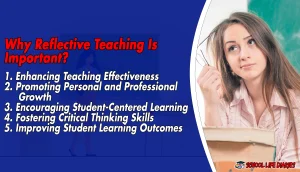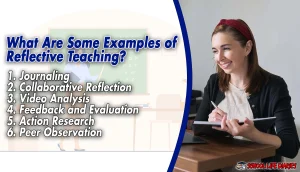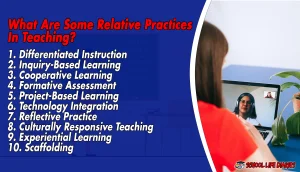In the dynamic and ever-evolving world of education, teacher reflection plays a pivotal role in shaping young minds and guiding the path to knowledge. But have you ever wondered what goes on behind the scenes, beyond the classroom walls?
Teacher reflection is the key that unlocks the door to continuous growth and improvement in the realm of education. It is a process that allows teachers to delve into their teaching practices, examine their experiences, and gain valuable insights that can enhance their effectiveness in the classroom.
In this blog post, we will explore the power of teacher reflection, its impact on professional development, and the profound influence it can have on student learning outcomes. Get ready to embark on a journey of self-discovery and uncover the transformative world of teacher reflection.
Why Reflective Teaching Is Important?
1. Enhancing Teaching Effectiveness:
Reflective teaching provides educators with the opportunity to critically analyze their instructional practices and identify areas for improvement.
By reflecting on their teaching methods, strategies, and approaches, teachers can make adjustments that enhance their effectiveness in the classroom.
It allows them to refine their instructional techniques, adapt to the diverse needs of their students, and foster a more engaging and impactful learning environment.
2. Promoting Personal and Professional Growth:
Reflective teaching cultivates personal and professional growth by encouraging self-awareness and continuous learning. Through reflection, educators gain deeper insights into their teaching strengths and areas for development.
They can identify their professional goals, seek opportunities for professional development, and actively pursue growth in their teaching practice. Reflective teachers are committed to lifelong learning and are open to exploring new ideas and innovative approaches to enhance their instructional skills.
3. Encouraging Student-Centered Learning:
Reflective teaching places a strong emphasis on student-centered learning. By reflecting on their teaching practices, educators can assess the effectiveness of different instructional strategies and adjust them to meet the diverse needs and learning styles of their students.
This process allows teachers to create a more student-centered and inclusive classroom environment, where students feel valued, engaged, and empowered to take ownership of their learning.
4. Fostering Critical Thinking Skills:
Engaging in reflective teaching cultivates critical thinking skills among both teachers and students. Reflective teachers encourage students to think critically about their own learning process, encouraging them to reflect on their strengths, weaknesses, and areas for improvement.
Through guided reflection activities, students develop metacognitive skills, become more aware of their learning strategies, and develop a deeper understanding of their own learning needs. This empowers students to become independent learners and critical thinkers.
5. Improving Student Learning Outcomes:
One of the most significant reasons why reflective teaching is important is its positive impact on student learning outcomes. By constantly evaluating and refining their instructional practices, teachers can make informed decisions that optimize student learning experiences.
Reflective teachers can identify and address any barriers to learning, tailor their instruction to meet individual student needs, and provide timely and meaningful feedback. This proactive approach to teaching leads to improved student engagement, achievement, and overall learning outcomes.
What Are Some Examples of Reflective Teaching?
1. Journaling: The Power of Self-Reflection
Reflective journals allow teachers to document their thoughts, observations, and experiences in the classroom. Through journaling, teachers can reflect on their teaching strategies, student interactions, and lesson outcomes.
Engaging in regular self-reflection helps teachers identify patterns, assess their effectiveness, and generate ideas for improvement.
2. Collaborative Reflection: Learning from Colleagues
Collaborative reflection involves engaging in discussions and sharing experiences with fellow teachers. Teachers can form professional learning communities to discuss challenges, successes, and innovative practices.
Through collaborative reflection, educators gain diverse perspectives, valuable feedback, and practical strategies for improvement.
3. Video Analysis: A Window into Teaching
Recording classroom lessons and analyzing them allows teachers to objectively assess their instructional practices.
Watching the videos, teachers can observe their body language, pacing, student engagement, and instructional clarity.
Video analysis provides an opportunity for self-reflection and enables teachers to make targeted improvements in their teaching.
4. Feedback and Evaluation: Learning from Student Input
Seeking feedback from students through surveys, questionnaires, or one-on-one conversations. Students’ perspectives can offer valuable insights into teaching methods, clarity of instructions, and classroom dynamics.
Teachers can reflect on student feedback to adjust their teaching approaches, incorporate student suggestions, and enhance the learning experience.
5. Action Research: Investigating Teaching Practices
Action research involves conducting small-scale studies to investigate specific teaching strategies or interventions.
Teachers collect data, analyze results, and reflect on the effectiveness of their instructional practices.
Action research allows teachers to make evidence-based decisions, refine their teaching methods, and continuously improve their practice.
6. Peer Observation: Learning from Each Other
Engaging in peer observation, where teachers visit each other’s classrooms and provide constructive feedback. Observing other teachers allows for reflection on alternative teaching techniques, classroom management strategies, and student engagement methods. Peer observation promotes a collaborative culture of reflection and encourages professional growth.
Reflective teaching encompasses various practices that promote self-reflection, collaboration, and growth. By incorporating these examples of reflective teaching into their professional practice, educators can continuously improve their instructional methods, enhance student learning experiences, and evolve as effective and impactful educators.
What Are Some Relative Practices In Teaching?
1. Differentiated Instruction:
Differentiated instruction involves tailoring teaching methods, content, and assessment to meet the diverse needs and learning styles of students.
Teachers use a variety of instructional strategies, materials, and assessments to accommodate individual student strengths, interests, and abilities.
2. Inquiry-Based Learning:
Inquiry-based learning encourages students to explore and investigate real-world questions and problems. Teachers facilitate the learning process by posing thought-provoking questions, guiding investigations, and promoting critical thinking and problem-solving skills.
3. Cooperative Learning:
Cooperative learning promotes collaboration and active participation among students. Teachers structure activities that require students to work together in groups, fostering communication skills, teamwork, and shared learning experiences.
4. Formative Assessment:
Formative assessment involves gathering ongoing feedback on students’ understanding and progress during the learning process.
Teachers use a variety of assessment tools, such as quizzes, discussions, and observations, to identify areas of strength and areas that need further development.
5. Project-Based Learning:
Project-based learning engages students in hands-on, real-world projects that require critical thinking, creativity, and problem-solving skills.
Teachers guide students through the process of researching, planning, and presenting their projects, promoting deep understanding and application of knowledge.
6. Technology Integration:
Technology integration involves incorporating technology tools and resources into teaching and learning activities.
Teachers use digital tools, multimedia resources, and online platforms to enhance engagement, promote collaboration, and provide personalized learning experiences.
7. Reflective Practice:
Reflective practice involves regularly reflecting on teaching methods, strategies, and experiences. Teachers engage in self-reflection, seek feedback, and make adjustments to improve their instructional practices and enhance student learning outcomes.
8. Culturally Responsive Teaching:
Culturally responsive teaching acknowledges and values students’ cultural backgrounds, experiences, and identities.
Teachers create an inclusive and supportive learning environment that respects diversity, incorporates culturally relevant content, and promotes equitable opportunities for all students.
9. Experiential Learning:
Experiential learning involves providing students with hands-on, real-life experiences to deepen their understanding and make connections to the curriculum.
Teachers organize field trips, simulations, and interactive activities that allow students to apply knowledge in authentic contexts.
10. Scaffolding:
Scaffolding refers to providing temporary support and guidance to students as they develop new skills and knowledge.
Teachers provide structured support, gradually reducing assistance, to help students work independently and achieve academic goals.
Conclusion: Teacher Reflection
Reflecting on our teaching practices is an essential aspect of professional growth and student success. Throughout this blog post, we have explored the importance of reflective teaching and its various benefits.
We have seen how reflective teaching promotes self-awareness, critical thinking, and continuous improvement. By engaging in reflective practices, teachers can enhance their instructional strategies, create a positive learning environment, and meet the diverse needs of their students.







